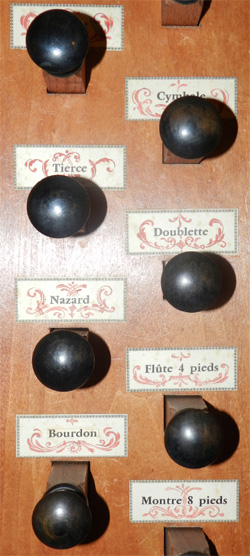

Organ : 2 Keyboards , pedalboard - 17 stops
An archive document mentioned in "Orgues Comtadines and Provençales", a book published by Norbert Dufourcq, describes the composition of an instrument of the 17th century situated in the church Saint-Agricole in Avignon. This composition corresponds to the organ, present today in the collegiate church Saint-Martin in Roquemaure. Pierre Chéron, organ builder (1922-1990), who revealed the major interest which represented this instrument made the link between this archive document and the organ on which he was working in Roquemaure in the years 1967-70. Since then, the organ is considered as an authentic instrument of the 17th.
Composition :
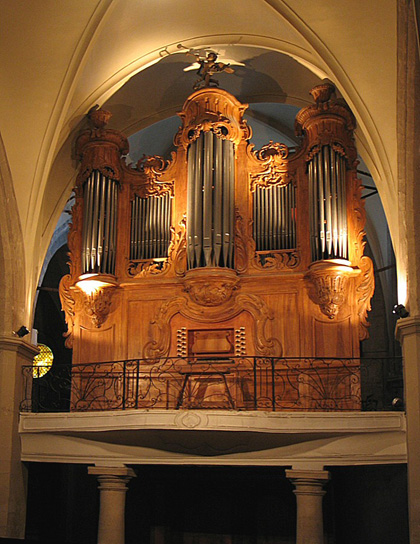
| Grand-Orgue - 48 notes | Récit - 25 notes | Pédale -8 notes : |
| ut,ré,mi,fa,sol,la,sib,si | ||
| Montre 8' | Cornet V rgs : | Flûte 12' |
| Bourdon 8' | ( Flûte 8-4' + | Bombarde 12' |
| Prestant 4' | Cornet III rgs ) | |
| Flûte 4' | ||
| Doublette 2' | ||
| Nazard 2 2/3' | ||
| Tierce 1 3/5' | ||
| Larigot 1 1/3' | ||
| Fourniture II rgs | ||
| Cymbale III rgs | ||
| Trompette 8' | ||
| Cromorne 8' | ||
| Vx Humaine 8' | ||
| Grand Cornet V rgs |
Mild tremulant soft - Rossignol
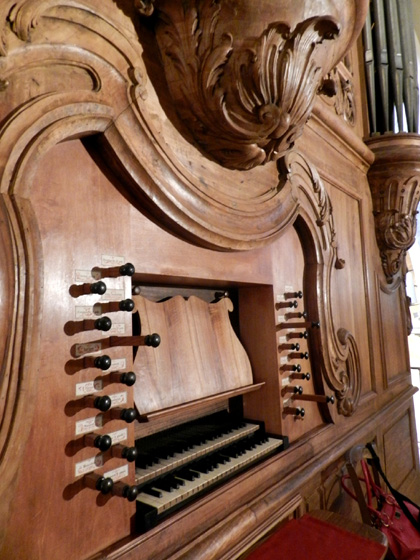
The instrument was then classified as "Historic Monument" and a complete restoration was begun in 1985. The works concerned the restoration of the case, the windchests, the whole mechanic, the extension of all the pipework to find the original tone (415hz at 18°), the creation of a Cornet of Récit, of two missing reed stops : Cromorne and Voix humaine, and the return to the particular organization, original, of the two Pedal stops.
At last, it involves too the construction of new keyboards and the temporary adaptation of an horizontal bellow, awaiting 3 cuneiform bellows to come.
The dating of this instrument does not make the unanimity. Certain organ builders and experts, consider that it is rather a set completely recomposed at the beginning of the 19th century by an Italian organ builder. As such, it is necessary to remind, that actually Italian organ builder worked in Provence and more exactly in Comtat venaissin, at the beginning of the 19th century. It was the case for the organ of l'Isle sur Sorgue, built in the 17th by the Flemish Le Royer and "Italianized" by Mentasti. We can hear and also admire the organ of the city of Avignon today, called collectively " the golden organ " built by the organ builder Piantanida around the years 1820.
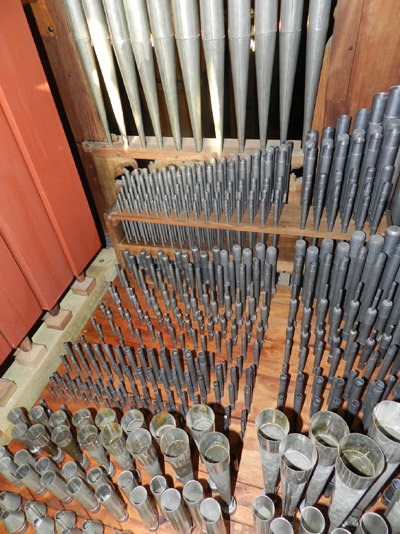
But, in any event, both windchests of the organ, entirely in walnut and of a magnificent made, seem to have been really conceived to contain the actual pipes. The composition of the organ, perfectly in compliance with the archive document, is not the one of an Italian organ, just like the rest of the instrumental part which, obviously, is of a French plan.
The made of the pipes, on the other hand, is very similar to those of some ancient organs still numerous in Italy: lead flattened and then scraped, rich metal, typical Italian mouth flatted. The only differences : the height of mouths, a little higher, and the more reduced opening of the feet, the wind pressure being high, 91mm (water column) . This pressure was determined by the thickness of the original tongues of the trumpet.
The back of the case is filled with graffiti of any times. One of them, in red chalk, mentions works realized in 1720. The shape of the writing is ancient without ambiguity. Yet, in the collegiate church of Roquemaure, there was no organ at that time … This seems to confirm Pierre Cheron's hypothesis, which indicates that the organ would come from Avignon and that it corresponds very exactly to the archive document published by Norbert Dufourcq. The case, of a style difficult to date exactly, also could be from the 17th, it is enough to contemplate the surprising decorations of the turrets which inevitably remind the wigs of Louis XIV-Louis XV style.
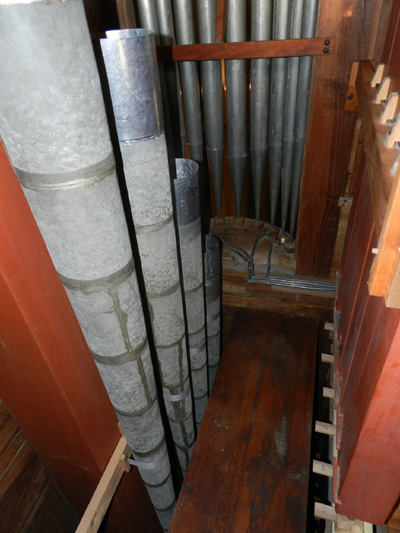
The pipework, almost complete, is built with a principle of establishment of simple measures as those who govern the Plenum : from the Montre 8' up to the last rank of the Plein-Jeu, it is about the same system of diameters' progression, in other words it is the same diapason which has been used to build the Montre, the Prestant, the Doublette and the ranks of the Plein-jeu. The stopped pipes, Bourdon 8', Flute 4', Nasard, have the same measures as those of the Plenum (for the same height of tone), they are simply cut to the half.
The trumpet is of white iron, equipped with shallots open almost in the middle of their diameter. The Pedal Bombard looks like in every respect that of " the gilded organ " of the city of the popes' palace in Avignon. We lenghtened all this pipework to obtain the tone 415 Hz. This determination of the tone is the result of the complete study of the facade, where the tracks of the original tuning slots were perfectly recognizable. The temperament is a by-product of the temperament Rameau. No interval of tierce is really pure. The objective is to avoid the reduction too much pronounced by the fifths which, in the case of a mésotonique temperament with 8 pure tierces, produce inevitably a conflict with those, pure, of the Plein-jeu. The intervals of tierces : do /mi, Mi / Sol#, la/ Do#, Ré, Fa#, sol /Si, Fa / La, are thus slightly bigger of a beating period, equivalent to that of a "mild" tremulant's one. The consonance of the chords is almost as well satisfactory as that generated by the complete mésotonique temperament.
Bombarde 16 foot in white iron :
